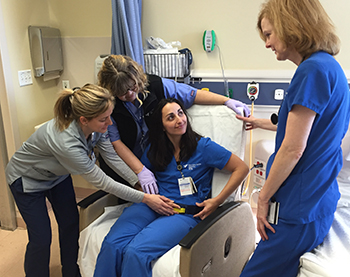
On the NICU, Anna Coppola, RN, (seated) demonstrates the hook and loop belt designed to help prevent falls. L to r are: Dawn Wicker, physical therapist; Carol Daniels, patient care associate; and Ann Thornton, RN.
The Neurosciences Intensive Care Unit (NICU) went over a year without a patient fall, despite caring for people who are at high risk.
What's the staff's secret?
There isn't one.
"Everyone on the unit is consistently following the hospital's fall-prevention policy," said Dawn Wicker, a physical therapist and YNHH Fall Prevention Committee co-chair. "It's about getting back to basics."
In 2014, NICU staff began seeing an increase in preventable falls among their patients, many of whom have conditions that can affect their thinking and coordination. Unit leaders discovered most falls occurred in the bathrooms or when patients got out of chairs in their rooms.
That prompted Patient Service Manager Kelly Poskus, RN, Assistant PSM Nona Timario, RN, and Anna Coppola, RN, the unit's fall prevention champion, to re-educate staff on the hospital's fall-prevention protocols. These include "Stay With Me," which requires a unit staff member to stay within arm's reach of patients while they're in the bathroom.
"This can be embarrassing to patients, so we gave staff scripting to help them explain that this is for their safety, not to invade their privacy," Coppola said. In addition, during morning and evening safety huddles, staff discuss high fall-risk patients and tools to keep them safe, such as increased patient care associate rounding. Other successful fall-prevention measures the unit initiated include:
- Targeted, pre-emptive toileting, in which staff round on patients regularly to get them to the bathroom with assistance.
- The use of bed alarm pads for ICU beds. These sound earlier than traditional ICU bed alarms, which do not go off until the patient is out of bed. With the new pads, staff can respond quicker to patients getting out of bed.
- Hook and loop belts in place of chair pads. The belts alert staff earlier when a patient is trying to get out of the chair.
The NICU's fall prevention is particularly impressive given the unit's early mobility efforts, in which staff get patients up and moving as soon and as often as possible to help restore function.
"It's been a real team effort, not only with NICU staff, but with the physicians and other staff members who care for our patients," Poskus said. "We've all made fall prevention a top priority."